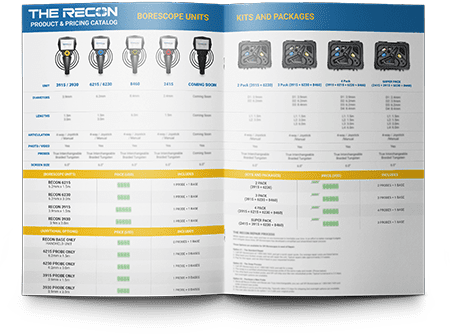What is a Videoscope?
The invention of the videoscope is a huge breakthrough that has helped many industries with their inspection and maintenance processes. Videoscopes, sometimes referred to as video borescopes, are the best tool for gaining visual information from otherwise inaccessible areas. They share the same basic utility as a standard borescope but rely on micro digital cameras and lights to send images to the operator.
DIFFERENCES BETWEEN VIDEO AND NON-VIDEO EQUIPPED BORESCOPES
As we stated, videoscopes share the same basic physical design as your standard rigid borescope, but they are completely different tools in terms of operation and quality. While the basic rigid borescopes use optical lenses to project images from the tip of the borescope to the operator’s eyepiece, a videoscope uses a small, medical grade camera in order to send images to a video screen in real time. That doesn’t mean the videoscope isn’t equipped with other optics. A videoscope will have an optical lens, image sensor, and something to illuminate the scene, such as several LED lights surrounding the camera.Unlike a simpler (non-video) borescope, a videoscope requires a control unit as well as a readout monitor. While the rigid borescope’s tube has a serious of optical components, a videoscope only has a signal for transmitting the digital image information.
HOW DO VIDEOSCOPES ACTUALLY WORK?
A videoscope is a simple, yet complex, piece of equipment. The video end of the borescope is an optical piece of equipment with an objective lens on it. An optical system connects this lens and the eyepiece of the borescope. Videoscope technology provides a direct view of an object or component, or a field of view. The viewing angle is the scope of the view captured by the video optics.The handheld unit on a videoscope has an HD LCD screen and controls that are attached to a braided tungsten steel insertion probe, with a medical grade camera on the tip. On videoscopes, the handheld portion is where you control zoom, video recording, picture taking, and video playback — the camera tip itself is controlled by a joystick for easy control while articulating.As far as what you get out of the camera, it sends back high-quality pictures and is equipped with illumination to make sure you get the clearest view in the darkest spaces. On the video end, the camera is allowed to articulate a full 360 degrees. Once the video and pictures are recorded, they are stored on an SD card at the handheld end. Technicians can then take this card to a computer, or other devices, for a complete and thorough examination. This is a huge advantage when using videoscopes; you are no longer limited to what you catch while doing the inspection. You can review the inspection at a later time, take your time examining the footage, and even get a second or third opinion on the footage. Engineers can even use their inspection footage to teach others what to look out for during maintenance inspections and set a benchmark standard for quality. There’s no way to get more accurate and thorough inspection information than by using a videoscope.
TYPES OF INDUSTRIES USING VIDEOSCOPES
Nearly every single manufacturing or industrial company out there uses videoscopes in their daily, weekly, monthly, and yearly inspections and as needed for repairs. We have clients in many industries including:
AUTOMOTIVE:
The uses of automotive borescopes are endless. From the assembly line to catastrophic engine failure, a videoscope is an essential tool for mechanics and manufacturers alike.
AVIATION/AIR CRAFT:
From drones to commercial airliners, the aviation and aircraft industries count on videoscopes for the near constant safety inspections. When there’s a lot to inspect between flights and not a lot of time to do the inspection, the videoscope is a reliable way to get the job done.
ENERGY AND POWER:
From traditional to renewable energy generation, articulating videoscopes keep the energy flowing. These systems and plants are extremely thorough when it comes to making sure everything is working as it should. When one component is worn or breaks, it can shut down power generation for longer than can be afforded. Using a videoscope during regular inspections can help operators get ahead of any problems that might cause grid disruptions, as well as helping them to quickly identify parts that need to be prepared.
MILITARY AND DEFENCE:
The military and defense sectors can incorporate a lot of different industries. These industries use a lot of heavy-duty equipment, and borescopes provide a way to quickly and thoroughly inspect all types of large equipment, from vehicles to aircraft, and everything in between.
MANUFACTURING:
Manufacturing plants that produce goods, chemicals, and any kind of byproduct at all require a lot of moving parts to make sure the process of production is running smoothly. Regular inspection prevents costly repairs and minimizes the chances of having to cease production.
GAS AND OIL:
When it comes to gas and oil industries, they are faced with some of the strictest maintenance standards and regulations of any industry. This is because they deal with dangerous and environmentally damaging processes and byproducts. The industry also requires the use of massive pieces of equipment. For these reasons, and more, the oil and gas industries are heavily regulated on their inspection intervals as a part of their maintenance records, and video inspection with an articulating borescope is the only way to properly inspect this equipment efficiently.
DIFFERENT MODELS OF VIDEOSCOPES
We have a well-rounded product line of videoscopes, check out these options and what makes them unique:
X1 SERIES: This is a sleek and durable unit with the most responsive articulation on the market. It is portable with a magnetic base, so you can attach it to metal surfaces for hands-free inspection. It is also one of the most versatile scopes with the option of several different interchangeable camera probe lengths and diameters.
MC1 SERIES: This mechanical articulating borescope has cutting-edge features, military-grade durability, and impressive battery life. It’s also available in several different diameters and lengths.
JCM SERIES: The JCM 3000 pipe inspection system is a high-end digital borescope that has interchangeable cameras, 30 meter insertion tube, and upgraded features. The borescope has a 7.5-inch display and a lithium-ion battery that lasts up to four hours.
DG1 SERIES: This flexible videoscope is a great economical option, perfect for the small shop mechanic or people who work in residential plumbing. It brings all the basic features of a videoscope at an extremely affordable price, and has different probe options to choose from.
ULTRA-THIN SERIES: As you can imagine, some of the tight inspection spaces require a thin camera for small insertion points and computer components, and that’s exactly what this scope provides.
Now that you know all about videoscopes, CALL US NOW to Demo them on your inspections!


